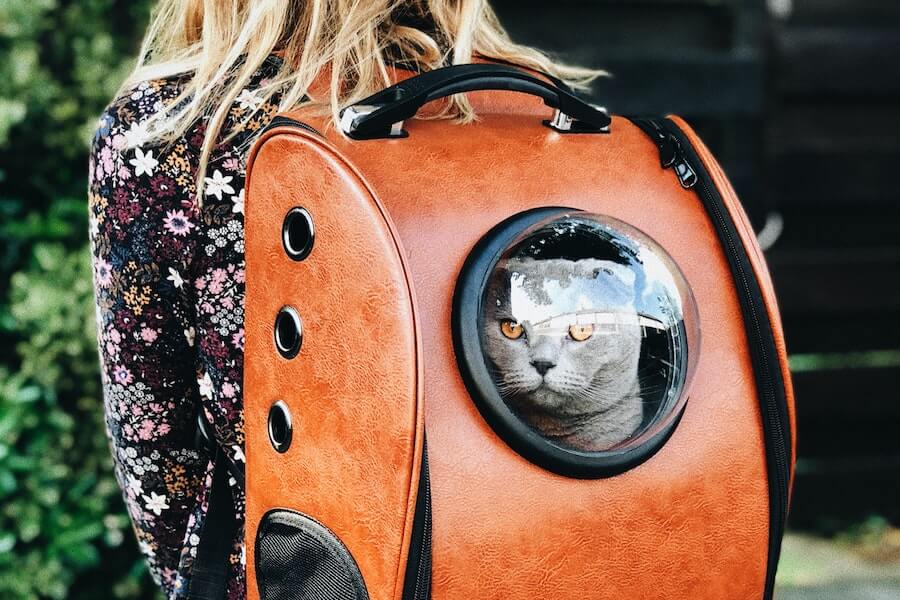Moving home with pets can be a stressful and worry-filled time for you and your family. Still, with a few simple ideas, we can help you navigate that problematic territory of moving with cats to minimise the worry of that part of the job so that at the end of the road your cat or cats can settle into and be happy in their new environment.
You want to avoid that scary retort ‘Oh no Cynthia, where’s the cat?’ by taking some simple steps to help your cat move and settle into their new environment.

Topics in this article:
How to prepare cats before a move?
Cats, by nature, develop strong bonds with their environment through smell. They territorialise by rubbing their neck and facial glands which secrete feline facial pheromones recognisable to them and other cats establishing their territorial boundaries.
As a result, a change of environment means a major disruption for them, creating a potentially stressful situation. Therefore they have to explore and re-establish their new territory which may intersect with other feline boundaries leading to clashes over territory. With all of this in mind, training your cat to use a crate can be one of the best ways to move with cats. When a cat accepts a crate as its home/safe place, it won’t see areas outside of this as their territory, which will result in a much easier transition during the move and during the settling-in phase.
This type of forward-thinking can alleviate much of a cat’s stress and lead to a seamless transition, preparing your cat for a move.
One other thing you can do with cats when moving a short distance
Notify the neighbours from your current address about your upcoming move so that they might be able to alert you if your cat turns up there down the track. Cats have an incredible sense of direction, so be cautious about letting them out without supervision as they may try to return to their old home. As mentioned, the crate is going to help avoid cat anxiety when moving house, so this is still your best bet.
What to do with cats when moving house
- The best way to move with cats is a day before the move, allocate one room in the house with doors and windows closed and a sign on the door to alert the removalists and family members not to let the cat out. Ensure this room is vacated last on moving day.
- Place the cat’s familiar things like food and water bowls, the carrier you intend to use for transport, toys, carpeted scratching pole, favourite sleeping mat, litter tray etc., in the same room but also make sure the room is well ventilated. Feed the cat three hours before departure and then remove the food.
- On arrival at the new home, allocate a single room again and follow the steps above to allow the cat to become familiar with their new surroundings.
Moving with a cat in a car
If you’re moving with cats or a cat in your car, then they will feel more comfortable having you in the car, and if it’s not a short trip, it is advisable to get your cat used to travelling in your vehicle. Again, if your cat is crate trained then moving them in your car is going to be a breeze.
Moving with multiple cats
If you’re moving house with multiple cats, then crate training is highly recommended, as this will give them a safe place that they get used to that becomes their haven. The key is to start crate/carrier training weeks or even months prior, and unlike dogs, you should leave them open and accessible at all times. The key is to help them own this space, so using the crate for all outings is going to make them own this quicker and make your move all that much easier.
How to move with a cat long distance?
- Before moving day, place the cat in the carrier/crate you have chosen for the trip ensuring the cat has reasonable space to turn around. A suggested good spacing would be a width x2, height x1 and length x1.5 cats. Give the carrier a spray with synthetic feline facial pheromones available from your vet before placing your cat in the carrier.
- Make sure you use a carrier so that you and the cat remain safe on the journey no matter how far that might be.
- Also, if you haven’t already, talk to your vet about microchipping your cat and ensure your current contact details are easily found on their collar. Central Animal Records have a registry of domesticated animals and boasts some 4 million animals on their microchip database for pets.
- When you are about to depart, place the cat in the carrier in a well-ventilated part of the car, preferably on the back seat and not buried under luggage.
- Remember cars can heat up very quickly, so leave the aircon on if stopped for any amount of time in transit and keep the cat hydrated well with regular opportunities for a drink and toileting breaks.
- Please beware of the run-off potential at any break you have, we recommend using a light leash to ensure you don’t lose your feline friend in some unfamiliar transit stop.
- If unsure, the use of a cattery or a friend to watch your cat while you transfer to your new home may solve many problems for you.
Moving overseas with cats
If you are moving interstate or further abroad with a cat, there is, even more, to take into consideration and a travel approved crate is going to be a must. Sedation though, is not recommended as it can affect their blood pressure and overall be very harmful to them.
The good news is that many airlines will allow you to have your cat in the cabin or at a minimum with the cargo. Each Airline will have its own rules, but it’s a relatively easy process. The biggest thing will be checking regulations with the country that you are moving to so that your cat will be accepted into quarantine.
Key tips for moving countries with your cat
- Don’t feed your cat/s eight hours before the flight. Otherwise, they will likely end up not feeling great on the journey.
- Don’t sedate your cat but a product like FELIWAY Spray, can offer comfort and reassurance on the trip.
- Check cat vaccination regulations on both ends of your travel destination.
How to help your cat settle into a new home
- Allow the cat to become familiar with the new home gradually, maybe one room at a time each day. Do not allow the cat outside for two weeks at least and then only under strict supervision.
- Leave some food in various places around the new environment, so it becomes an adventure of discovery for the cat.
- Nervous cats look for narrow, concealed close quarters when they are afraid or feeling insecure.
- If your cat doesn’t seem interested in eating, provide regular small meals and maintain the same routine as you did in the old address.
- Use some cotton gloves or a cloth to rub on doorposts and furniture legs etc. having rubbed them around your cat’s neck and cheek glands first. This begins the process of familiarisation for your feline friend.
How long to keep your cat inside after moving
Overall your cat needs to learn to be comfortable in its new environment as quickly as possible to help avoid your cat getting lost. The length of time you need to work with your cat will vary, but it will often be at a minimum a couple of weeks or even a month before they get comfortable in your new home. It could take longer if they are not crate trained, as they need to mark their new territory, own the new place and then feel safe again.
Below are a few tips to help your cat/s transition to both the outdoor and indoors safely:
- An outdoor cat might need a cat run setup until it becomes familiar with your new yard.
- Check out the environment outside but don’t force your cat to go outside as they need to explore the new environment at their own pace but under supervision.
- Be aware of your next-door neighbour’s dogs/pets, local government regulations regarding pets, cat curfews, microchipping laws, busy roads and other hazards in your new neighbourhood.
- Keep your cat inside at night for their safety.
- Cats have an incredible sense of direction so be cautious about letting them out without supervision as they may try to return to their old home.
- Advise the animal registry of your new address in case your cat heads back to the old address. The Australian Animal Registry is the largest and most comprehensive not-for-profit animal registry and recovery service with a database of more than 1.8 million animals across Australia and New Zealand.
- For cats that are senior and have trouble climbing or getting up the stairs, an excellent site giving some great ideas to help the aged feline is Zee Zoey.
A word of caution
If moving overseas or even crossing state borders, be aware of transport regulations, quarantine and vaccination regulations at both ends of the journey.
The RSPCA recommends keeping cats inside from dusk to dawn to minimise disease, injury and predation on local wildlife.
At the end of the day
Moving interstate, locally or even overseas with your cat needn’t be the hassle you might first envisage. The key thing you need to do is be aware of your cat’s behaviour and apply this knowledge to ensure you keep things as familiar as possible for your furry friend. There’s, unfortunately, no quick trick to help your cat settle in, like the butter on the paws trick (unless you like butter all over your new house and the chance of slipping over yourself), it is an old wives’ tale.
Overall, one of the most important things is to keep your cat calm in the new house and ensure you are aware of the new local surroundings. If you do these key tips discussed in this article, your special furry friend will settle in with no problem, and you can enjoy your lovely new home together.









I have two cats and recently moved to a new apartment. I was quite worried about how they’d go with the move and everything changing – but I found that aiming to keep things familiar and easing them into the new environment made the transition so smooth.